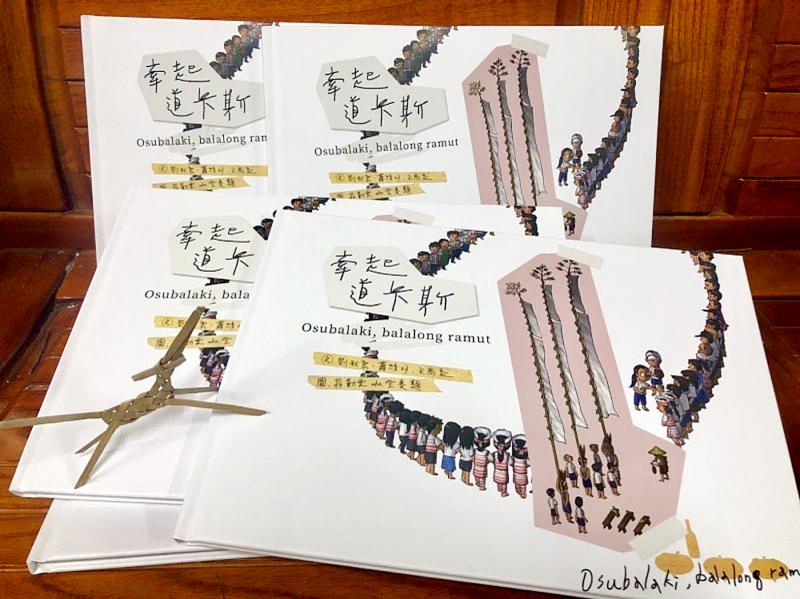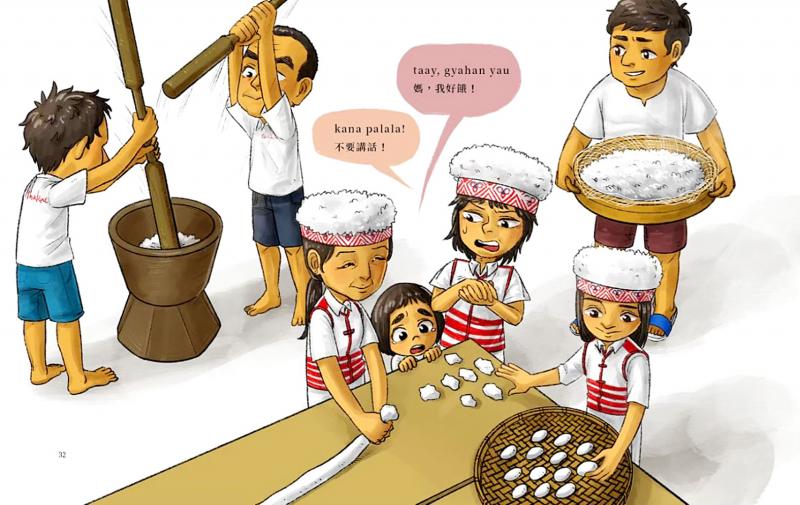It’s impossible to write a book entirely in the Taokas language. There are only about 500 recorded words in the indigenous tongue, whose speakers shifted to Taiwanese generations ago while preserving certain Taokas phrases in their speech.
“When I first started recording the language around 1997, I really had to jog the memories of the elders to find anything,” says Liu Chiu-yun (劉秋雲) a member of the Taokas community and a language researcher.
The Taokas last month unveiled a picture book, Osubalaki, Balalong Ramut the community’s first-ever commercial publication using the language. The lavishly illustrated book details their annual kantian festival, which was revived in 2002 after they stopped holding it in 1947 due to cultural suppression.

Photo courtesy of Weng Chin-wen
The main text is in Chinese and English, with Romanized Taokas words and dialogue sprinkled throughout. The book was gifted to all elementary and junior high schools in Miaoli as well as Singang (新港) residents. The Taokas are members of the Pingpu, or plains Aborigines, a community that has yet to be recognized by the government. They reside primarily in Miaoli and Nantou counties.
Kaisanan Ahuan, a Pingpu activist, says that many readers heard of his people for the first time through the book. He only learned that he was Taokas in college and has been studying the language for several years.
“It doesn’t matter if one can only speak simple phrases,” he says. “There’s a prayer during the kantian festival that must be recited in Taokas, otherwise we cannot proceed. It’s very important to us. And if people my age don’t use it, it will disappear.”

Photo courtesy of Weng Chin-wen
CULTURAL RESURRECTION
Kaisanan grew up in Puli Township (埔里) in Nantou County, where a significant number of Taokas migrated in the 1800s from their original homeland along the central coast. Aside from a few Taokas words he heard from elders, he knew nothing about his Taokas roots until he visited Singang in northern Miaoli, where the culture is better preserved.
Liu says the entire village spoke Hoklo when she was little, and although they would sprinkle Taokas into their speech, she didn’t know it was a different language.

Photo courtesy of Weng Chin-wen
“My aunt would say that my son is very obedient during long car rides and doesn’t samali (cry),” Liu says. “I thought that was Hoklo, but she was using Taokas.”
After recording what she could from elders, she began teaching it to whoever wanted to learn. However, because the Taokas have yet to gain official recognition, their language cannot be part of the public school curriculum.
In 2014, the Council of Indigenous Peoples began providing financial support to Pingpu groups to publish books in their own language. At first, the Taokas hung basic vocabulary signs around Singang, and in January last year the Taokas Cultural Association published its first dictionary.
Kaisanan, who heads the Central Taiwan Pingpu Indigenous Groups Youth Alliance, says the existence of Taokas is crucial to gaining recognition.
“Without [our own] language, it’s very hard to convince the government that we’re a separate group,” he says.
The book is a lively depiction of the preparations for the 2018 kantian festival. The most distinct feature are the male dancers with 30 meter-high bamboo flags tied to their backs. A few elders in the community even remember participating in it as children.
The book contains a photo from the Japanese colonial era of villagers posing with the giant flags. For many, it was the first time they had ever seen an image of the old festival. The authors found the photo in a book by late National Taiwan University anthropologist Hu Chia-yu (胡家瑜).
“Many people were quite moved when they saw the photo,” Liu says. “So the kantian that we heard elders speak of really did happen. Some villagers recognized people in the photo too.”
IMMERSIVE RESEARCH
Kaisanan says the Taokas chose the picture book format because it will appeal to a broader audience. The story revolves around the 2018 festival, so villagers will be familiar with it, as the illustrations accurately depict the real-life participants as well as local scenery.
Liu says that besides kantian, Taokas children have few opportunities or outlets to learn about their ancestral culture.
“It’s another way to preserve our language,” he says.
Before illustrating the book, Weng Chin-wen (翁勤雯) helped with the murals depicting traditional life that adorn the buildings and walls in Singang. She also completed a picture book in 2018 for the Pingpu Kahabu community’s muzaw a azem, a Lunar New Year festival.
For the Taokas project, Weng participated in the kantian festival and interviewed elders. But as a woman, she did not have access to certain preparations and rituals restricted to Taokas men.
Even Liu had never seen the complex process of tying the flagpoles to the dancers’ backs until she asked her cousin to film it for Weng last year. Using the footage, Weng repeatedly revised her illustrations until the elders deemed them accurate.
Kaisanan and Liu say they want to create more educational material in the future, partially to help their efforts to win government recognition.
“We hope that the government sees that we do have the resources and materials to teach [Taokas],” Kaisanan says.
Liu says she is happy about the “small progress” the community has made preserving Taokas over the past two decades, but she also worries about its future.
“Our population is small, and it’s not a language that can be used daily. The practical applications are very limited,” she says. “But we have to do what we can.”

This is the year that the demographic crisis will begin to impact people’s lives. This will create pressures on treatment and hiring of foreigners. Regardless of whatever technological breakthroughs happen, the real value will come from digesting and productively applying existing technologies in new and creative ways. INTRODUCING BASIC SERVICES BREAKDOWNS At some point soon, we will begin to witness a breakdown in basic services. Initially, it will be limited and sporadic, but the frequency and newsworthiness of the incidents will only continue to accelerate dramatically in the coming years. Here in central Taiwan, many basic services are severely understaffed, and

Jan. 5 to Jan. 11 Of the more than 3,000km of sugar railway that once criss-crossed central and southern Taiwan, just 16.1km remain in operation today. By the time Dafydd Fell began photographing the network in earnest in 1994, it was already well past its heyday. The system had been significantly cut back, leaving behind abandoned stations, rusting rolling stock and crumbling facilities. This reduction continued during the five years of his documentation, adding urgency to his task. As passenger services had already ceased by then, Fell had to wait for the sugarcane harvest season each year, which typically ran from

It is a soulful folk song, filled with feeling and history: A love-stricken young man tells God about his hopes and dreams of happiness. Generations of Uighurs, the Turkic ethnic minority in China’s Xinjiang region, have played it at parties and weddings. But today, if they download it, play it or share it online, they risk ending up in prison. Besh pede, a popular Uighur folk ballad, is among dozens of Uighur-language songs that have been deemed “problematic” by Xinjiang authorities, according to a recording of a meeting held by police and other local officials in the historic city of Kashgar in

It’s a good thing that 2025 is over. Yes, I fully expect we will look back on the year with nostalgia, once we have experienced this year and 2027. Traditionally at New Years much discourse is devoted to discussing what happened the previous year. Let’s have a look at what didn’t happen. Many bad things did not happen. The People’s Republic of China (PRC) did not attack Taiwan. We didn’t have a massive, destructive earthquake or drought. We didn’t have a major human pandemic. No widespread unemployment or other destructive social events. Nothing serious was done about Taiwan’s swelling birth rate catastrophe.